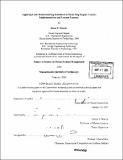| dc.contributor.advisor | Henry S. Marcus. | en_US |
| dc.contributor.author | Murphy, Brian P. (Brian Patrick), 1963- | en_US |
| dc.contributor.other | Massachusetts Institute of Technology. Dept. of Ocean Engineering. | en_US |
| dc.date.accessioned | 2006-07-13T15:24:00Z | |
| dc.date.available | 2006-07-13T15:24:00Z | |
| dc.date.copyright | 2004 | en_US |
| dc.date.issued | 2004 | en_US |
| dc.identifier.uri | http://hdl.handle.net/1721.1/33433 | |
| dc.description | Thesis (S.M.)--Massachusetts Institute of Technology, Dept. of Ocean Engineering, 2004. | en_US |
| dc.description | Includes bibliographical references (p. 58). | en_US |
| dc.description.abstract | The United States Navy is under pressure to reduce the cost of fleet maintenance in order to redirect funds for the construction of new ships and submarines. The Navy looks to private industry for process improvement ideas such as the Theory of Constraints, Six Sigma and Lean Manufacturing Principles. This thesis examines the Lean Manufacturing movement in the private sector of ship repair and how it eventually came to government owned ship repair operations. Recent National Ship Research Program (NSRP) initiatives provide shipyards a strategy of how to select areas of an operation for Lean improvements. The Norfolk Naval Shipyard method is a combination of the Theory of Constraints, Six Sigma and Lean Principles called Lean Sigma. The Lean Sigma methodology for planning, executing and sustaining lean improvement and how to measure success with various metrics is presented. Lean Sigma is implemented into the Electric Motor Rewind and Repair Center as a case study. Before and after assessments, lessons learned, and recommendations from the implementation case study are presented. | en_US |
| dc.description.abstract | (cont.) Details of the challenges and pitfalls encountered during the Lean Sigma implementation in the areas of culture, budget, management, metrics and cost benefit measurement, are described throughout the test case. In conclusions key elements for successful Lean transformation and a vision for the future Lean Ship Repair Enterprise are presented. | en_US |
| dc.description.statementofresponsibility | by Brian P. Murphy. | en_US |
| dc.format.extent | 58 p. | en_US |
| dc.format.extent | 3592492 bytes | |
| dc.format.extent | 3594828 bytes | |
| dc.format.mimetype | application/pdf | |
| dc.format.mimetype | application/pdf | |
| dc.language.iso | eng | en_US |
| dc.publisher | Massachusetts Institute of Technology | en_US |
| dc.rights | M.I.T. theses are protected by copyright. They may be viewed from this source for any purpose, but reproduction or distribution in any format is prohibited without written permission. See provided URL for inquiries about permission. | en_US |
| dc.rights.uri | http://dspace.mit.edu/handle/1721.1/7582 | |
| dc.subject | Ocean Engineering. | en_US |
| dc.title | Applying lean manufacturing initiatives to naval ship repair centers : implementation and lessons learned | en_US |
| dc.type | Thesis | en_US |
| dc.description.degree | S.M. | en_US |
| dc.contributor.department | Massachusetts Institute of Technology. Department of Ocean Engineering | |
| dc.identifier.oclc | 62868732 | en_US |

